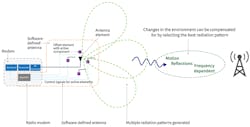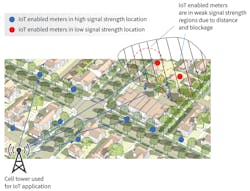Smart Antennas Steer Mission-Critical IoT Applications
Download this article in PDF format.
Use of Internet of Things (IoT) technology is ramping up, with many of the use cases falling into vertical markets such as agriculture, finance, and asset tracking. For most of these applications, a small-form-factor radio modem with passive antenna will suffice for good connectivity.
However, for some mission-critical IoT applications, such as public safety or asset tracking in high multipath environments encountered in factories and oil refineries, or ATMs and vending machines located in basements of buildings where signals are weak, a better antenna system can be key to successful communication link performance. A smart, or software-defined, antenna (SDA) can provide the extra performance needed to close the link in more challenging IoT environments. The performance enhancements that SDAs can bring to a radio system will typically be range and reliability.
IoT devices that use cellular modems and networks for communications will not be alone on the network, whether it’s 4G LTE or 5G, since IoT devices on any cellular network will compete with others for network resources. Smartphone-enabled consumers continue to drive up congestion on the cellular networks that IoT devices require for connectivity. In congested cellular environments, an SDA approach will provide several decibels of system-level improvement compared to client devices that incorporate only passive antennas.
Basics of Smart Antennas
A smart, or software-defined, antenna can be dynamically reconfigured so that it’s optimized for changes in the radio protocol, propagation channel, or other variations in the operating environment. This reconfigurability can take the form of a beamsteered antenna that’s able to dynamically direct the peak gain in the intended direction of propagation to improve the communication link quality. When the antenna radiation pattern can be modified to direct the peak gain in a specific direction, two benefits emerge:
- The gain increase realized by better pointing of the antenna beam results in signal-to-interference-and-noise-ratio (SINR) improvements that translates into a stronger transmitted or received signal.
- The directive antenna pattern tends to reduce the antenna gain in other directions, resulting in better interference mitigation of undesired signals.
Compared to commonly used passive antennas, an SDA provides a beamsteering function that can direct signal gain at the optimal direction or area of the communication link. This improved gain at the intended node of a cellular network along with interference suppression makes it possible to optimize both signal and interference, which substantially improves SINR. This improved SINR will increase the range and reliability of the communication link.
An SDA system can bring multiple additional decibels of gain and system-level benefits compared to a conventional passive antenna. This is particularly true when dynamic optimization of the radiating element is incorporated along with signaling from the baseband modem chipset and an algorithm to command the antenna optimization.
Besides more gain in the intended direction, an SDA that provides a directive steered beam will reduce the level of interfering signals arriving from directions other than the direction of the intended base station. The underlying principle at play is the relationship between gain and beamwidth of an antenna. As a higher peak gain in the radiation pattern is generated, other angular regions will be under-illuminated, i.e., lower gain in directions outside of the main lobe of the radiation pattern.
If an SINR metric is available from the baseband modem chipset for use by an algorithm to optimize the SDA, then the interference aspects of the propagational channel will be considered as the radiation pattern characteristics are surveyed and optimized. This attribute is becoming more important in today’s cellular networks as a more-dense layout of base stations or nodes are being deployed to keep up with capacity demands. As more base stations are deployed, interference becomes a more limiting factor in terms of link reliability and throughput compared to signal strength.
Figure 1, depicting a radio modem and an SDA, highlights the capability of an SDA to generate multiple radiation patterns that can be selected from to optimize for the propagation channel. Another possible reconfigurability path with an SDA-based product is an antenna that can change frequency response as frequency bands are switched to optimize the communication link One more possibility is an antenna that can be dynamically impedance-matched to accommodate changes to the near-field of the IoT modem/antenna module.
1. This diagram shows how a mobile software-defined antenna and radio modem receive signals from a base-station transmitter.
SDAs have become more feasible in the last several years due to innovations on two fronts: RF modem chipset design and RF tuning components. These two component types or subsystems will be linked together and communicate with each other to provide the dynamic control needed to optimize a software-defined antenna to a changing environment.
In terms of chipsets for 4G and Wi-Fi modems, the metrics available for “real-time” dynamic optimization are available at moderate to low latency, with these metrics typically including SINR, received signal strength indicator (RSSI), and channel quality indicator (CQI). Metrics like these can be used to make decisions as to optimal antenna system tuning state.
On the RF tuning component side, a wide variety of components and manufacturing techniques to support these components has matured over the last 10 years. The component list includes RF switches, RF tunable capacitors, microelectromechanical-systems (MEMS) switches and tunable capacitors, and PIN diodes. The important attribute of the tuning component is the ability to connect or disconnect portions of an antenna or change reactance at a junction of an antenna, and to do this quickly to allow for “real-time” antenna reconfigurability.
Combining Antennas with Software
As well as the antenna design itself, the software in the form of an algorithm to drive the SDA is key to optimizing the radio modem/antenna combination to the propagation channel or environment. The algorithm will access a handful of metrics from the radio baseband processor and use them while sampling radiation patterns from the antenna to decide which radiation pattern provides the most benefit for a specific scenario or point in time.
It’s important to mention “point in time,” because things can and do change in the local environment that require a surveying of the SDA’s radiation patterns to ensure optimal communication link performance. A well-configured software-defined antenna will have an algorithm coupled to it that can quickly access these baseband metrics to allow for real-time optimization.
An SDA that provides a beamsteering function can provide 3 to 6 dB (or more) of additional antenna system gain. This added gain directly translates to 3 to 6 dB of system-level gain, which can result in higher data rates, a more reliable connection, and increased communication range.
With many IoT applications developed to handle low data rates, the main benefits that an SDA can bring to the mix are range improvements and link reliability. Thanks to the improved antenna system gain provided by an SDA, IoT devices can be placed further from an established cellular base station and still maintain connectivity. For ISM-based systems, the improved antenna gain will mean less infrastructure spend and management, since more range and performance can be achieved from existing equipment.
A more reliable connection will come into play when an IoT device is used on a cellular- or ISM-based network and devices are in weaker signal areas, such as basements, or congested areas like urban environments. The beamsteering function of an SDA effectively provides “antenna diversity” from a single antenna, with the single antenna looking like many antennas as radiation patterns are changed and sampled.
Exploring an Example
Figure 2 offers an example of an application that would benefit from a beamsteering function designed into a software-defined antenna. The application is a cellular-based utility metering system implemented in neighborhoods. The existing cellular towers provide adequate signal strength across most regions of the neighborhood, but several homes are located at an extended distance from the cell tower and/or suffer from blockage of the cellular signal from adjacent houses.
2. As shown in this example configuration of a cell tower and IoT devices, many factors can lead to weak signal regions.
The utility meters shown in red are prime examples of IoT-enabled devices that could benefit from an additional 3 to 6 dB of antenna system gain to overcome distance and blockage issues. Implementing an improved antenna system on the IoT devices at these disadvantaged locations proves to be a cost-effective choice compared to putting in additional cellular infrastructure.
For IoT devices operating by means of a cellular network, an SDA can be the difference between being connected or not. It will provide the added system performance needed for demanding IoT applications where maintaining a reliable connection is important. The 3 to 6 dB of antenna system gain achievable from a beamsteering function in the antenna system can be used to extend the signal range as well as improve the reliability of the overall system by maintaining a better communication link.
Today’s cellular and LoRaWAN modems have the capabilities for real-time optimization from an algorithm-based SDA, and a wide variety of switching and tuning components can be used in the antenna system design for dynamic optimization of one or more antenna characteristics. Instead of relying on further improvements to the node or cellular tower side of the link, an SDA can bring the benefits of beamsteering antennas to the anticipated large number of client devices as new and more IoT applications are brought to market.
Jeff Shamblin is Vice President of Engineering at Taoglas.



